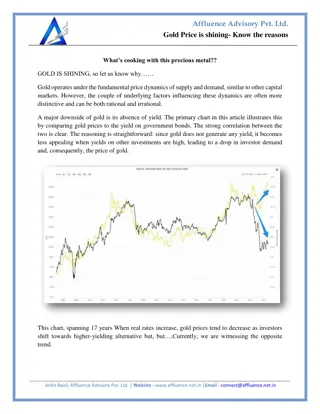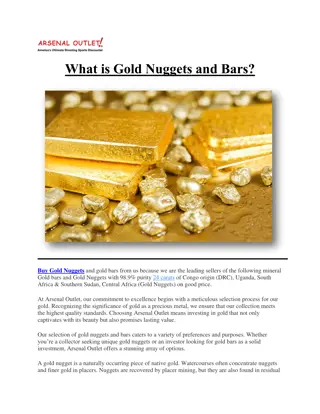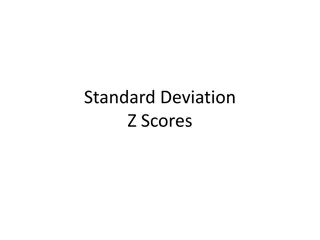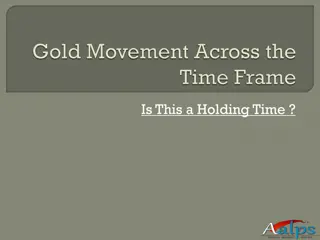The Evolution of the Gold Standard in the U.S.
Delve into the historical significance and principles of the Gold Standard in the U.S., examining its impact on currency value, money supply, international trade, and key legislative acts like the Coinage Act of 1792. Discover how the Gold Standard has shaped economic policies and historical periods like the Interwar period.
Download Presentation

Please find below an Image/Link to download the presentation.
The content on the website is provided AS IS for your information and personal use only. It may not be sold, licensed, or shared on other websites without obtaining consent from the author.If you encounter any issues during the download, it is possible that the publisher has removed the file from their server.
You are allowed to download the files provided on this website for personal or commercial use, subject to the condition that they are used lawfully. All files are the property of their respective owners.
The content on the website is provided AS IS for your information and personal use only. It may not be sold, licensed, or shared on other websites without obtaining consent from the author.
E N D
Presentation Transcript
The Gold Standard in the U.S. The opinions expressed are solely those of the presenters and do not reflect the opinions of the Federal Reserve Bank of Dallas or the Federal Reserve System.
Principles of a Gold Standard The unit of currency is backed or fixed to a certain amount of gold (or the price of a unit of gold is set). The nation will buy and sell gold freely at the predetermined price (the mint price).
Link between Money Supply and Gold An increase in the amount of monetary gold can lead to an increase in the money supply. If everything else holds constant, as the supply of money rises, the price level increases. A decrease in the amount of monetary gold can lead to an decrease in the money supply. If everything else holds constant, as the supply of money falls, the price level decreases.
Implementation of a Gold Standard Multiple forms Pure coin standard Mixed standard Bullion standard Gold exchange standard Varied across time and among nations
Gold and Trade Gold standard guaranteed the value of currency for international trade Risk of loss from trade with unknown or unstable currencies minimized Domestic vs. International role of money
U.S. Legislation Coinage Act of 1792 established Mint and created a bimetallic (gold/silver) standard Coinage Act of 1834 increased mint price of gold and created a de facto gold standard. Legal Tender Act of 1862 removed the U.S. from the gold standard.
U.S. Legislation Resumption Act of 1875 requires that U.S. currency be redeemed for coin. It puts the U.S. on a de facto gold standard. Gold Standard Act of 1900 formalized the adoption.
Historical Periods Classical gold standard Interwar period Bretton Woods After the gold standard post Bretton Woods
Classical Gold Standard 1880 1914 59 countries total with four core countries U.K. U.S. France Germany Unprecedented global economic growth first era of globalization
Theoretical Principles of Gold Standard Fixed exchange rates based on the price of gold Free movement of gold between countries National policies that encouraged the international flow of gold to follow levels of economic activity Gold standard was priority over domestic economic concerns
Classical Gold Standard Classical economic thought Economies tended toward full employment Government intervention was unnecessary or irrelevant
Classical Gold Standard in U.S. Substantial deflation following Civil War was required to return to gold. Industrial Revolution concentrates wealth in urban areas. Discord between eastern capitalists and western farmers gave rise to populism. William Jennings Bryan and the Cross of Gold speech Bimetallic standard would allow inflation
Unemployment in U.S. 10 9 8 7 6 5 4 3 2 1 0 1890 1892 1894 1896 1898 1900 1902 1904 1906 1908 1910 1912 1914 Historical Statistics of the United States Millennial Edition Online Table Ba470-477 Labor force, employment, and unemployment: 1890 1990 http://hsus.cambridge.org/HSUSWeb/toc/tableToc.do?id=Ba470-477
Change in Price Level in U.S. 6.00% 4.00% 2.00% 0.00% -2.00% -4.00% -6.00% -8.00% -10.00% -12.00% 1865 1868 1871 1874 1877 1880 1883 1886 1889 1892 1895 1898 1901 1904 1907 1910 1913 FRB Minneapolis CPI (Estimate) http://www.minneapolisfed.org/community_education/teacher/calc/hist1800.cfm
Financial Sector Instability Bank panics occurred in 1873, 1884, 1890, 1893 and 1907.
U.S. Congress Responds to Instability Federal Reserve Act of 1913 Specific concern interest rate spikes caused by liquidity crises, banking panics and seasonality Federal Reserve s mandate provide liquidity and stabilize interest rates (not price stability)
World War I Countries needed to finance deficit spending on the war effort by selling bonds (e.g. Liberty Bonds) To protect gold reserves, core countries suspended redemption and limited exports of gold
World War I in U.S. U.S. deficits financed through the sale of war bonds (Liberty Bonds) Excess gold reserves allowed increases in the money supply and low interest rates U.S. price level doubled during WWI
Interwar Period in U.S. After the war, the Federal Reserve raised interest rates creating deflation and unemployment Mint price of gold restored in 1922 Sterilization of gold flows created price stability for U.S. during 1920 s
Interwar Period in U.K. England returned to the gold standard in 1920 Deflationary monetary policy cost the U.K. over one million jobs
Great Depression To curb Wall Street speculation, the Federal Reserve raised rates at the end of the 1920 s. Worsening economic conditions worldwide created a domino effect of speculative currency attacks.
Great Depression May 1931 Run on Austria s largest commercial bank. July 1931 After the collapse of an important German bank, Germany adopts exchange controls. Sept. 1931 Redemptions of the pound sterling for gold prompt the U.K. to suspend convertibility.
Great Depression U.K. s departure from the gold standard led to speculative attacks on the U.S. dollar. Bank withdrawals and gold redemptions caused bank panics and failures. Faced with supporting the banking system or protecting the dollar, the Federal Reserve raised rates to secure the gold reserves.
Great Depression President Roosevelt declares a bank holiday to stabilize banking system. Presidential Order 6102 (1933) prohibits private holdings of gold coin, gold bullion and gold certificates. Gold Reserve Act of 1934 All monetary gold owned by the government Only Federal Reserve Banks allowed to hold gold certificates
Great Depression Nations left the gold standard in groups U.K., Japan and Scandinavian nations (1931) U.S. and Italy (1932-33) France, Poland, Belgium and Switzerland (1935- 36) Evidence shows that an early departure from the gold standard hastened a nation s economic recovery.
Change in Price Level in U.S. 20.00% 15.00% 10.00% 5.00% 0.00% -5.00% -10.00% -15.00% Consumer Price Index for All Urban Consumers: All Items U.S. Department of Labor: Bureau of Labor Statistics www.bls.gov
Bretton Woods Accords Sought to blend the policy of fixed exchange rates of the gold standard with the flexibility to respond to domestic economic conditions International Monetary Fund coordinated adherence to the accord Member countries required to peg their currency to gold or to the U.S. dollar
Bretton Woods U.S. Role Committed to exchange dollars for gold Allowed other central banks to hold reserves in dollars, rather than gold Pressure on this commitment U.S. balance-of-payments deficit led to large dollar reserves in other countries Inflationary monetary and fiscal policies in U.S. U.S. inflation devalued dollar reserves around the world.
End of Bretton Woods Era 1960s countries largely sterilized dollar inflows 1971 international demand to convert dollars to gold peaked and Nixon suspended convertibility to protect U.S. gold reserves 1973 formal end of Bretton Woods
Post Bretton Woods Exchange rates are no longer fixed (floating). Monetary policy seeks to achieve national economic goals. Monetary authorities must maintain price stability without the arbitrary constraint of a gold standard.
A Policy Dilemma: The Mundell Fleming Model Independent monetary policy Free capital flows Fixed exchange rates
Money and gold have no use or value in themselves in short, our wealth lies neither in vaults at Fort Knox nor on the ledgers of our banks. Rather, it lies all around us, in what we have so prodigiously produced in the past and what we are capable of producing in the future. Peter L. Bernstein
Resources Ahmed, Liaguat (2009), Lords of Finance: The Bankers Who Broke the World (New York: Penguin Press). Bernanke, Ben (2004), International Monetary Reform and Capital Freedom (Remarks at the Cato Institute 22nd Annual Monetary Conference, Washington, D.C., October 14). Bernanke, Ben (2004), Money, Gold and the Great Depression (Remarks at the H. Parker Willis Lecture in Economic Policy, Washington and Lee University, Lexington, Va., March 2). Bernstein, Peter (2008), A Primer of Money, Banking and Gold (Hoboken, N.J.: John Wiley & Sons). Bordo, Michael D. (1981), The Classical Gold Standard: Some Lessons for Today, Federal Reserve Bank of St. Louis Review, May. Bordo, Michael D. (1993), The Gold Standard, Bretton Woods and Other Monetary Regimes: A Historical Appraisal, Federal Reserve Bank of St. Louis Review, vol. 75, no. 2, March/April. Brands, H.W. (2006), The Money Men: Capitalism, Democracy, and the Hundred Years War over the American Dollar (New York: W.W. Norton & Co.). Brunner, Robert F., and Sean D. Carr (2007), The Panic of 1907: Lessons Learned from the Market s Perfect Storm (Hoboken, N.J.: John Wiley & Sons). Butterman, W.C., and Earle B. Armey III (2005), U.S. Geological Survey Mineral Commodity Profiles Gold, Open File Report 02-303 (Reston, Va., U.S. Department of the Interior and U.S. Geological Survey, June). Kenen, Peter B. (2008), Bretton Woods System, The New Palgrave Dictionary of Economics Online (Palgrave Macmillan), www.dictionaryofeconomics.com/article?id=pde2008_B000198> doi:10.1057/9780230226203.0161. Officer, Lawrence H. (2008), Gold Standard, The New Palgrave Dictionary of Economics Online (Palgrave Macmillan), www.dictionaryofeconomics.com/article?id=pde2008_T000204> doi:10.1057/9780230226203.0653. Thorson, Eric M. (2011), Statement of the Inspector General, Department of the Treasury, Before the House Committee on Financial Services, Subcommittee on Domestic Monetary Policy and Technology (Washington, D.C., June 23). Throop, Adrian W. (1976), Bicentennial Perspective Decline and Fall of the Gold Standard, Federal Reserve Bank of Dallas Business Review, January.

 undefined
undefined






















